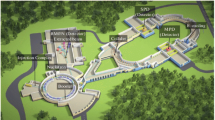Abstract
The PHENIX experiment consists of a large detector system located at the newly commissioned relativistic heavy ion collider (RHIC) at the Brookhaven National Laboratory. The primary goal of the PHENIX experiment is to look for signatures of the QCD prediction of a deconfined high-energy-density phase of nuclear matter quark gluon plasma. PHENIX started data taking for Au+Au collisions at √sNN=130 GeV in June 2000. The signals from the beam-beam counter (BBC) and zero degree calorimeter (ZDC) are used to determine the centrality of the collision. A Glauber model reproduces the ZDC spectrum reasonably well to determine the participants in a collision. Charged particle multiplicity distribution from the first PHENIX paper is compared with the other RHIC experiment and the CERN, SPS results. Transverse momentum of photons are measured in the electro-magnetic calorimeter (EMCal) and preliminary results are presented. Particle identification is made by a time of flight (TOF) detector and the results show clear separation of the charged hadrons from each other.
Similar content being viewed by others
References
The PHENIX Collaboration: D P Morrison, Nucl. Phys. A638, 565c (1998)
J D Bjorken, Phys. Rev. D27, 140 (1983)
E Kistenev et al, Proceedings of the Fifth International Conference on Calorimetry in High Energy Physics (World Scientific, 1994) pp. 211–223
G David, et al, IEEE Trans. Nucl. Sci. 45, 692, 705 (1998)
We used Woods-Saxon nuclear density distribution, Au nucleus radius R=6.65 ± 0.3 fm, diffuseness a=0.54 ± 0.01 fm and nucleon-nucleon cross section σnn=40 ± 5 mb
WA98 Collaboration: M M Aggarwal et al, nucl-ex/0008004
F Antinori et al, Preprint CERN-EP-2000-002
PHOBOS Collaboration: B B Back et al, Phys. Rev. Lett. 85, 3100 (2000)
NA49 Collaboration: F Siklér et al, Nucl. Phys. A661, 45c (1999)
X N Wang and M Gyulassy, nucl-th/0008014
K J Eskola, K Kajantie, P V Ruuskanen and K Tuominen, Nucl. Phys. B570, 379 (2000) and hep-ph/0009246
e.g. see Proc. Quark Matter 1987 edited by H Satz, H J Specht, R Stock, Z. Phys. C38 (1988) pp. 1–370 Proc. Quark Matter 1999, edited by L Riccati, M Masera, E Vercellin, Nucl Phys. A661, pp. 1c–765c (1999)
E802 Collaboration: T Abbott et al, BNL-67641 (August, 2000) submitted to Phys Rev.
X N Wang and M Gyulassy, Phys. Rev. D44, 3501 (1991)
NA49 Collaboration: T Alber et al, Phys. Rev. Lett. 75, 3814 (1995)
X N Wang and Z Huang, hep-ph/9701227
X N Wang, Phys. Rev. C61, 064910 (2000)
WA98 Collaboration, M M Aggarwal, et al, Phys. Rev. Lett. 85, 3595 (2000)
J-Y Ollitrault, Phys. Rev. D46, 229 (1992)
P Danielewicz, Phys. Rev. C51, 716 (1995)
H Sorge, Phys. Rev. Lett. 78, 2309 (1997)
D Teaney and E V Shuryak, Phys. Rev. Lett. 83, 4951 (1999)
WA93 Collaboration: M M Aggarwal et al, Phys. Lett. B403, 390 (1997)
NA49 Collaboration: H Appelshäuser et al, Phys. Rev. Lett. 80, 4136 (1998)
WA98 Collaboration: M M Aggarwal et al, Nucl. Phys. A638, 459 (1998)
E895 Collaboration: C Pinkenburg et al, Phys. Rev. Lett. 83, 1295 (1999)
STAR Collaboration: K H Ackermann et al, Phys. Rev. Lett. 86, 402 (2001)
A M Poskanzer and S A Voloshin, nucl-ex/9805001
P F Kolb, J Sollfrank and U Heinz, nucl-th/9906003
D Teaney, J Lauret and E V Shuryak, nucl-th/0011058
G J Alner et al, Z. Phys. C33, 1 (1986)
PHENIX Collaboration: K Adcox et al, Phys. Rev. Lett. 86, 3500 (2001)
Author information
Authors and Affiliations
Additional information
For the PHENXI Collaboration
The word PHENIX is the abbreviation of Pioneering High Energy Nuclear Interaction Experiment.
Rights and permissions
About this article
Cite this article
Ghosh, T.K., Adcox, K., Adler, S.S. et al. First results from RHIC-PHENIX. Pramana - J Phys 57, 355–369 (2001). https://doi.org/10.1007/s12043-001-0045-5
Issue Date:
DOI: https://doi.org/10.1007/s12043-001-0045-5




